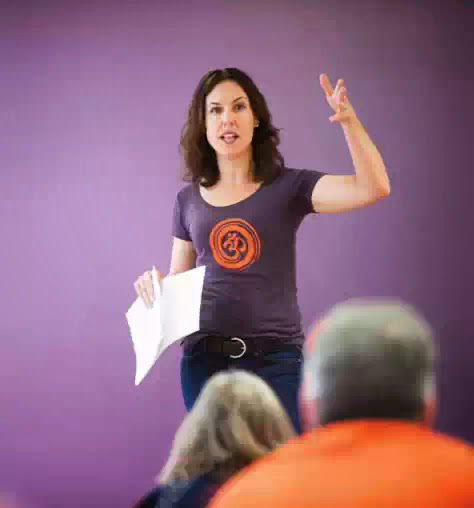* When a Dead Language Is Cutting-Edge *
* When a Dead Language Is Cutting-Edge *
Marcy Braverman Goldstein ’92 makes an enterprise out of an interest she once thought “obscure.”
By Karen McCally ’02 (PhD)
IN DEMAND: Based in Charlotte, N.C., Goldstein takes her Sanskrit workshops on the road, to places such as Willow Street Yoga Center, in Silver Spring, Md., where she conducted “Sanskrit: The Language of Yoga in Texts, A¯sana, and KIrtan,” in November. (Photo: Adam Fenster)
It’s not a typical path to entrepreneurship: a bachelor of arts in religion, followed by doctoral study of religion with training in what’s often considered a dead language to boot.
But the knowledge Marcy Braverman Goldstein’92 has painstakingly acquired, and which she shares with tuition-paying college students near her home in Charlotte, N.C., is knowledge she’s discovered many other people in her community would like to have themselves.
“I realized the knowledge from my education—the actual content of it—was something that many people truly want to know. And they don’t necessarily want to pay $2,000 to take a course at their local university,” Goldstein says.
Goldstein majored in religion at Rochester and developed a special interest in Hinduism and its scriptural language, Sanskrit. At the time, she says, “my interests seemed obscure.” But she continued her studies, earning a doctorate at the University of California at Santa Barbara.
Among the world’s most ancient languages, Sanskrit is rarely spoken. Yet it’s the language of an increasingly popular activity in the West: yoga. Yoga is a multimillion dollar industry in the United States alone. And as evidence has mounted for its benefits to physical and mental health, physicians and other health professionals have begun to integrate yoga in their treatment plans.
Yet the quality of yoga instruction is uneven, and an important element missing in much of it, Goldstein says, is Sanskrit.
Two years ago, she founded Sanskrit Revolution, a sole proprietorship through which she offers Sanskrit workshops for yoga instructors and students. She’s enjoyed as much demand as she can take on while still continuing to teach at the college level—something she has no plans to abandon.
Sanskrit words don’t just name every pose—or, in Sanskrit, a¯sana. Their sounds are an integral part of the practice of yoga itself. Some instructors have begun to incorporate more Sanskrit into their lessons—replacing English names for poses, such as the “corpse pose,” for example, with its Sanskrit name, śava¯sana—but with few places to turn for accurate knowledge of the language, mispronunciations are common.
Does it matter? That depends, Goldstein says. “For some people, yoga is just a physical fitness routine, and that’s fine.” But in her workshops in the Charlotte area, on the road, and at national conferences, she has identified a large community that wants a lot more out of yoga. “For many people,” she says, “it’s a way of life.”
This latter group is an eager audience for what Goldstein offers.
“Sanskrit is a language of sound, rhythm, and melody,” she explains. “What Sanskrit says about itself is that each sound has a particular vibration that is healing in a particular way.” Whether one accepts that argument or not, Goldstein says, most people agree that some sounds are inherently more peaceful than others. Although she notes that scholars generally reject the notion of a “pure Sanskrit”—a single, correct, and unchanging set of pronunciations—Goldstein also says, “There are some absolute mispronunciations.”
“I sometimes say to people, ‘How do you soothe a sleeping baby? Do you go to the baby and say, ‘kuh kuh kuh kuh’? Or do you say ‘shhhh’?,” she says.
In her workshops, she goes over the most commonly mispronounced āsanas, exploring their meanings by breaking the words down into their roots, and discussing the shades of meaning implied in each syllable. Participants in her workshops earn what’s called a CEU, or continuing education unit, part of an effort by the national governing body the Yoga Alliance to professionalize—a development Goldstein embraces, particularly given the increasing interest in yoga by health practitioners who’ve undergone rigorous training in their own fields.
She says Sanskrit Revolution wasn’t hard to get started. It grew out of something she was already doing. “I started teaching Sanskrit casually at some of the big yoga studios in L.A.,” she says, recalling her years as a graduate student in Santa Barbara. “People just kept coming back.”
As is the case for many entrepreneurs, digital tools have made it possible for her to reach a wide audience. She traces the start of her business to the day she bought the domain name for her website, www. sanskritrevolution.com, and has since added a Facebook page. In addition to a schedule, information, and links, Goldstein is working on a Sanskrit dictionary that will be downloadable as an app. She envisions adding to her website an online store for the purchase of study materials and Sanskrit Revolution gear. And she’s exploring online teaching as well.
On her website, Goldstein welcomes visitors by telling them the story of how she got interested in Sanskrit in the first place: as a student in the course Asian Search for Self, taught by Rochester professor of religion Douglas Brooks. Brooks, who also teaches outside the academy, says that in addition to her scholarly credibility, Goldstein is offering “accessibility to a very difficult and usually inaccessible subject.” And if yoga instructors were to learn “just enoughSanskrit—and they will if they study with Marcy—they bring credit to the traditions of India and to their own profession.”
For Goldstein, accessibility is perhaps the highest aim of Sanskrit Revolution. “I want to make this accessible,” she says. “It can only go so far in the confines of a university setting.”
© University of Rochester 1996-2012




Comments
Post a Comment